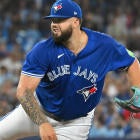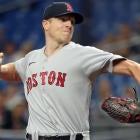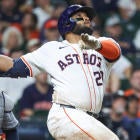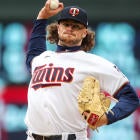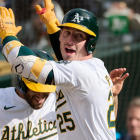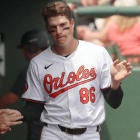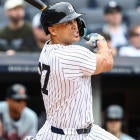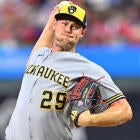Finally.
You've waited months. You've endured all of the basketball and hockey you can take. You wisely decided not to get involved in that Fantasy Dominican Winter League and you are about to be rewarded with the greatest day of the year for a Fantasy Baseballer: Draft Day.
Now that the day is here, however, you'll have to decide which way you want to go with your draft. If you are in a Rotisserie league, how long do you plan on waiting to pick your first closer? Are you going to gamble on some rookie pitchers, since they probably helped whoever won your championship last season? Have you correctly assessed the risk/reward of some players coming back from injury? Is it true you can outrun an alligator if you run in a zig-zag?
Forget all of those questions. What do you do with your first-round pick!?!
The Early Pick Gets the Stud
A lot of what you want to do in your draft depends greatly on where you are selecting. In other words, if you don't pick until the end of the first round, then you really don't have to be concerned with selecting between superstars Ryan Howard, Jose Reyes or Johan Santana after consensus No. 1 pick Albert Pujols. You'll be dealing with decisions over taking multi-faceted players like Carlos Beltran, Carl Crawford or Grady Sizemore, or studs returning after off years, like Vladimir Guerrero or Mark Teixeira. You can dig yourself a hole with a bad first-rounder, but don't forget that with 23 starting spots on a typical Rotisserie team, single picks in baseball aren't as significant as in Fantasy Football.
| 2007 DRAFT GUIDE! | ||
|
|
||

|
||
| Order your copy today! | ||
There's also an excellent chance that you'll have your choice of a pair of players you are targeting if you are drafting late in the first round. With that in mind, consider the team(s) you are sandwiched around. You might end up with both players if you work it right.
The first round is certainly not the spot to be taking gambles on players returning from injury or up-and-coming youngsters. As a matter of fact, it's tough to make the argument to grab either type of player in the first three or four rounds. Granted, if you took a chance on 2005 NL Rookie of the Year Ryan Howard in the first few rounds last season (he went in the seventh round of most drafts in '06) then you'd be sitting pretty. But success stories like his are few and far between when it comes to young players and Fantasy drafts.
Youth wasted on the young
|
Notable multi-pos. Elig. Players 20-games min. |
||
| Player | Positions | |
| Alfredo Amezaga, FLA | 2B/OF | |
| Rich Aurilia, SF | 1B/SS/3B | |
| Jose Bautista, PIT | 3B/OF | |
| Lance Berkman, HOU | 1B/OF | |
| Chris Burke, HOU | 2B/OF | |
| Mark DeRosa, CHC | 2B/3B/OF | |
| Chone Figgins, LAA | 3B/OF | |
| Aaron Hill, TOR | 2B/SS | |
| Shea Hillenbrand, LAA | 1B/3B | |
| Aubrey Huff, BAL | 3B/OF | |
| Cesar Izturis, CHC | 2B/SS | |
| Howie Kendrick, LAA | 1B/2B | |
| Julio Lugo, BOS | 2B/SS | |
| Victor Martinez, CLE | C/1B | |
| Nick Punto, MIN | SS/3B | |
| Xavier Nady, PIT | 1B/OF | |
| Freddy Sanchez, PIT | 2B/SS/3B | |
| Nick Swisher, OAK | 1B/OF | |
| Todd Walker, SD | 1B/2B/3B | |
| Ty Wigginton, TB | 1B/2B/3B | |
Consider what some rookie hitters did in the second half last year and you might bump them up your rankings just a bit more: Nick Markakis (.311-14-41, .896 OPS), Hanley Ramirez (.319-11-34, 44 XBH, .931 OPS), Luke Scott (.336-10-37, 1.047 OPS) and Josh Willingham (.283-15-30, .878 OPS). Ramirez is certainly an early-round pick to consider -- despite being a youngster -- because of his speed.
Getting ahead in the count
Another pivotal decision for you to make is how early should you go for starting pitching -- or relief pitching? You don't mind starting a pitcher trend, but you want to make sure the others follow. If not, it could be kind of like Will Ferrell in Old School. "We're going streaking!"
Since most rosters consist of 23 starting players (14 hitters, nine pitchers), you understand that hitting takes more of a premium. You also realize that most pitchers affect only four categories (in Rotisserie play) at best, rather than how many hitters can positively affect all five. With this in mind, it only makes sense to wait a bit on collecting most of your pitching -- especially in mixed leagues where there is plenty of pitching to go around.
If pitching starts to go too early though, like say in the second or third round, don't panic. Snatch up the hitters that fall to you and wait a couple more rounds before you pick up your pitchers. You'll likely still be getting the same grade of pitcher -- just two rounds later. Meanwhile, you've stashed away a 35-HR hitter or a 40-base stealer.
Last year was the first season in over a decade that no pitcher won at least 20 games in either league. The last time that happened was in 1995, the first year back after the strike. Six pitchers tied for the NL lead with 16 wins last year -- that's the lowest league-leading total in a non-strike season for either league since 1981.
The shift from aging veterans to young guns last season was obvious. Nine rookie pitchers won at least 10 games in '06. That total is the most since 2002, and it's as much as the past two years combined. We won't see a boost like that this season from a depleted rookie class, but the young ones from last season who flew under the radar could produce healthy sophomore campaigns.
And once again, the closer position is in flux. There is no other position that has as much turnover as this one. That's why holding over closers as keepers is a very dicey situation. For every Francisco Rodriguez and Huston Street, there is a Brad Lidge or Jose Valverde -- players you don't know what to expect from one game to the next.
Not as flexible as you once were
Something else to mull over this year is that unlike past seasons, there doesn't seem to be much flexibility among position players. For most leagues, a player has to have played at least 20 games at a position in order to be eligible there in the following season. Many players lost their flexibility altogether last year, like Chone Figgins (no longer 2B-eligible), Ryan Freel (OF only), Nomar Garciaparra (1B only), Alfonso Soriano (OF only), Jim Thome (DH only) and Josh Willingham (no longer C). So players like Mark DeRosa (2B-, 3B- and OF-eligible), Freddy Sanchez (2B, 3B and SS) and Ty Wigginton (1B, 2B and 3B) become a tad more valuable.
Just remember this: Your best draft strategy is being well-prepared, well-read and well-rested. There is always so much pressure placed on the draft, but remember that with trades and roster pick-ups, you have a decent shot of recovering within the next six months.
Have a question for the Fantasy Baseball writers? How about a comment or a suggestion? Feel free to email us at DMFantasyBaseball@cbs.com. Please add "Attn: Drafts" so we know which column you are referring to. We might not be able to answer all questions due to a large volume, but we’ll do our best.












